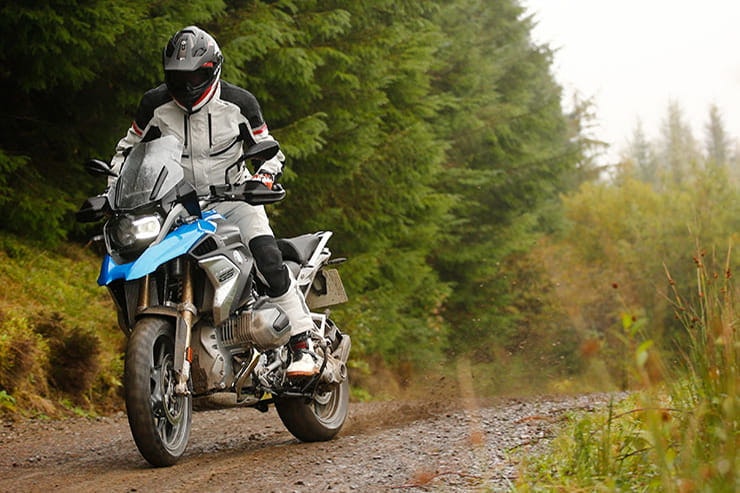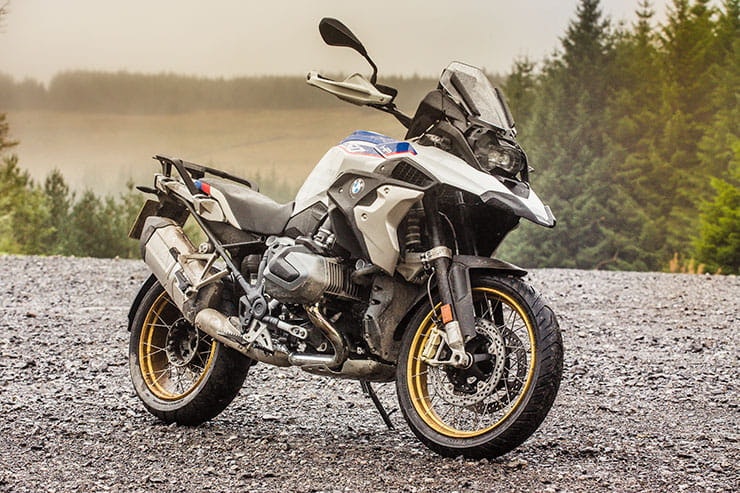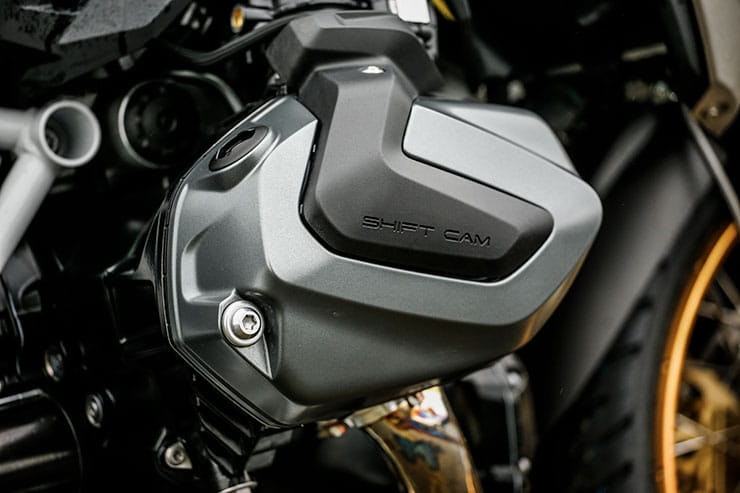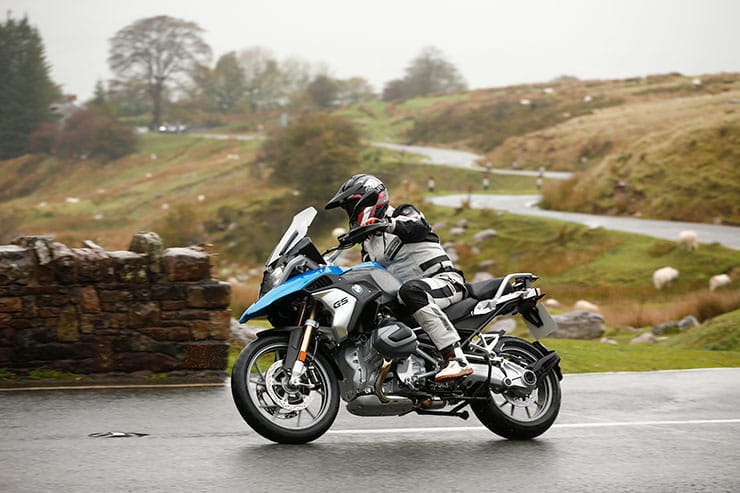BMW R 1250 GS (2019) - Review | UK Road & Off Road Review
BikeSocial Road Tester
23.10.2018
KIT CREDITS
Helmet
Shark Explore-R Peka (discontinued in r/w/b, now carbon only, still available from shops)
Product: £277.49
Gloves
Alpinestars Octane (discontinued)
Product: £n/a
The 2019 BMW R1250 GS has sensibly avoided a wholesale overhaul, targeting instead the areas it needed to improve; more torque and more power nudging the GS closer to its rivals, but without fundamentally altering the low-revving nature of its power delivery. And with lower emissions to keep it on the road through Euro5.
The most impossible job description in motorcycling belongs to the BMW engineer in charge of designing a replacement for the R1200 GS. How’s he/she supposed to make it better?
In case you missed it, the GS is the most popular bike of the last decade, topping sales in the UK and Europe since 2004. And it was still the best-selling 125cc plus motorcycle in Europe in 2017 – even though its last proper revamp was in 2013 (adding water-cooling to an engine and electronics overhaul). Last year, combined R1200 GS and GS Adventure sales were nearly 30,000 units; that’s over six per cent of all bikes sold in Europe. One in four of the top ten bikes sold was a GS or GSA. Most manufacturers would be cock-a-hoop with those figures for a brand new model, let alone what is essentially a five year-old bike.
Clearly, whatever the GS has been doing right, it’s been doing right for 14 years. And any attempt to make it better must surely risk making it worse.
So the challenge for 2019, Mr BMW engineer, is to take the best, most popular bike of the last decade and a half, and make it even better and even more popular. And definitely not cock it up.
Enter the new, 2019, BMW R1250 GS. No pressure then.
The new 2019 BMW R1250 GS: spot the differences with the R1200 GS.
BMW R1250 GS Prices
R1250 GS (base model, no semi-active suspension or Pro engine modes): £13,415
R1250 GS TE (semi-active, all rider modes, quickshifter, heated grips & much more): £16,200
R1250 GS Exclusive TE (+ styling extras): £16,500
R1250 GS Rallye (Motorsport colours, shirt screen, gold spoked rims, narrow seat, base engine & chassis spec): £13,950
R 1250 GS Rallye TE (+ full suspension and electronics spec package): £16,975
Learn a little more about the new R1250 GS by one of the men behind the project, Ulli Asst:
2019 BMW R1250GS & R1250RT unveiled
BMW Motorrad Project Manager, Ulli Asst, speaks about the new 1250cc engine in the GS and RT models at the Intermot 2018 show in Cologne.
Is the new GS still the ultimate crossover touring machine?
Power and torque
134bhp @ 7750rpm
106 lb.ft @ 6250rpm
Engine, gearbox and exhaust
The headline R1250 GS news is, as per the name, a bigger motor making more power and torque than a R1200 GS, aided and abetted by a novel variable valve timing system. Seeing as the R1200 GS’s peak power and outright performance was one easily identifiable weakness against its Ducati, KTM and Triumph rivals, it’s an obvious place to start updating your new GS.
And blimey yes, as I slosh around soaking wet Brecon Beacon roads in south Wales getting to know the new bike, it definitely possesses a torquier and more powerful motor than before. But it’s also significantly smoother. As my brain tries to focus on working out exactly which part of the power delivery is most enlarged over the 1200 GS (is the new bike stronger down low, has it got more midrange, or is the top end that impresses most?), my attention keeps being diverted instead by how much creamier the 1250 is than the 1200. Didn’t expect that.
Longer stroke, wider bores, bigger pistons, more torque and power. And variable valve timing to top it off.
Because the out-going GS isn’t an annoyingly vibey bike – it rocks and rumbles with a charming, loping, faintly wheezy chuckle, all bonkers BMW Boxer charisma. It talks to you. But the bigger 1250 motor is mechanically quieter, less lumpy and less obviously Boris Johnson than the 1200. The GS now comports itself with an extra layer of lustrous, insulating calm, as if it’s slipped seductively into a pair of expensive, fur-lined welder’s gloves – soft and kinky, but at the risk of feeling a bit isolated and remote. The engine’s combustion strokes are more masked than before, you can’t feel the engine’s heartbeat as clearly, and the sense of whirring lumps of metal pulsing around below is diminished. Miles will whisk by in even more sensory peace than before, at a more effortless cruising speed, but perhaps at the expense of some good old flat twin eccentricity. This is an observation as much as criticism; smooth things are generally more civilised, but possibly less interesting, than bumpy things – well, I think so.
The new 1250 also has a quieter exhaust note than the 1200 – less chuff, more of a deeper purr. The loudest noise while I’m riding is the rumble of the road surface under the front end. Or maybe it’s just down to a heavy Welsh session the night before.
One thing can’t be argued with is the 1250’s increased performance under my right wrist. Unable to decide which part of the rev range is most significantly improved, I give up and decide all of it is. Let’s face it; that’s the point of making the engine bigger.
Slotting up and down the gearbox (identical ratios as before and still with BMW’s legato quickshifter and autoblipper on the TE plus versions), the 1250’s bottom end is still surprisingly and wickedly punchy, but now there’s also a stack of brand-spanking midrange, and a small but perfectly formed battalion of stallions above 7000rpm ready to haul the GS into a brave new world of going really fast while sat bolt upright enjoying the view. If I had to quantify it, I’d say the 1250 is fitter than a 1200 GS off the bottom end (but with less snappiness off a closed throttle), less noticeably so in the midrange at part throttle, but significantly more powerful wide open at the top end... so, fitter everywhere, really. But other opinions are available; a datalogger will reveal the truth.
Power is up from 123bhp to 134bhp at the same 7750rpm peak, and peak torque is up from 92 lb.ft to 106 lb.ft, 250rpm lower than before at 6250rpm.
The out-going 1170cc motor’s relative lack of performance is one of the BMW’s weaknesses – its 123bhp peak power output is, on paper at least, short of the Ducati Multistrada and the KTM 1290 S Super Adventure’s 158bhp, and the Triumph Tiger 1200’s 139bhp.
In truth, on the road there’s less between them than dyno numbers suggest, due in part to the old BMW’s generous spread of performance levelling real-world riding, and also that, actually, most adventure bike owners probably care not much of a fig for such things. And, ridden in isolation, the old GS’ comparative lack of outright stomp is probably the last thing on their minds, as they sit back and enjoy peerless road-holding and supreme refinement. “I wish it was faster,” said not many 1200 GS owners, ever.
But more is better, we’re told – and, back-to-back with the 1200’s competitors, the out-going GS could feel marginally deficient gunning away from a standstill, or overtaking at speed. And if high performance in an adventure bike is make-or-break, then the R1200 GS needed more oomph to compete with KTM and Ducati. Maybe BMW think being underpowered has harmed GS sales. Anyway, the easiest way to get more vajazzle from an engine is to make it bigger, so it can gulp more air and burn more fuel, and make more lovely, lovely torque.
So that’s what BMW did. The new 1250 GS is actually 1254cc, and the old 1200 GS was 1170cc, so the new motor is 84cc bigger – and 7.2 per cent extra lung capacity is a healthy increase. Peak torque jumps 14 lb.ft to 106 lb.ft, but 250rpm lower than before, while peak power climbs 11bhp to 134bhp, but at the same revs.
BMW have achieved the relatively large increase in performance, without compromising the GS’s bottom-end friendly power delivery, by lengthening stroke as well as widening bores – from 101 x 73mm to 102.5 x 76mm. In broad terms, longer stroke favours peak torque at lower rpm and wider bores favour peak power at higher rpm (mainly for mechanical reasons). By maintaining the relationship between the two, BMW have kept the 1250 GS’ power delivery spread across the same rev range as the 1200 – only there’s more of it (in fact BMW have slightly reduced the 1250’s bore/stroke ratio and made it the least oversquare GS since the R100GS in 1986 – it’s also got the highest mean piston speed, and may also be the widest GS across the engine, too; we’ll need a back-to-back tape measurement to find out).
So bigger, deeper holes in the cylinders produce more power and torque – but the 1250 GS’ Shiftcam variable valve timing allows it to be harnessed more efficiently.
Shiftcam sounds like a shonky idea, but it’s actually a neat, simple and compact solution to optimising valve timing and lift.
It’s tempting to dismiss Shiftcam as another variable valve timing gimmick that adds complexity and cost, for no discernable benefit – as per Honda’s VFR800 VTEC system. But unlike VTEC (which isn’t variable valve timing, it’s simply switching a pair of valves on and off), BMW’s Shiftcam is entirely undetectable in use. And, unlike systems developed by Ducati, Kawasaki and as used on Suzuki’s GSX-R1000, Shiftcam also varies valve lift, as opposed to simply altering valve timing (however a variable valve timing system used by Suzuki on the Bandit 400 in 1991 varied timing and lift of both intake and exhaust valves).
Shiftcam does exactly as the name implies – the intake camshaft has two different cam lobes, with different profiles, for each intake valve. One is a mild cam lobe with less lift and shorter duration for sub-5000rpm and/or partial throttle openings; the other is a lumpier cam lobe with more lift and longer duration for high performance, wide-open throttle and/or 5000rpm plus engine speeds. The idea is to optimise valve timing and lift to match engine load over a greater range than a conventional valve train. And it’s entirely likely emissions tests are conducted with the engine running the partial cam lobe, to produce a Euro5-friendly result. It’s not cheating, just honouring emissions tests more in the breach than the observance.
To switch between partial-load and high performance cam lobes, the entire intake camshaft is literally shifted back and forth, by the width of a cam lobe, along its axis of rotation – the shaft is physically pushed along when an ECU-triggered actuator inserts a steel pin into a threaded shift drum on one end of the cam, which, as it rotates, alters the position of the camshaft accordingly. The shifting is timed to coincide with the identical heels of each cam lobe passing seamlessly over the corresponding finger rocker.
Furthermore, each intake valve runs a slightly different partial-load cam profile to its neighbour, so they open asymmetrically, one slightly before the other. The same idea is used on Honda’s CB1100, designed (according to Honda) to add an off-beat character to the inline four engine. BMW say they’ve done it to add turbulence to the mixture, meaning a more complete burn and better fuel efficiency and emissions.
Either way, fear not the new thing: the 1250 GS’ power delivery hasn’t the slightest trace of Shiftcam in operation. There’s no step in the revs, no surging, no change in engine note or character, and no detectable hint you’ve anything other than conventional valve-gear downstairs. If you didn’t know the new 1250 had variable valves, and you couldn’t decode the word ‘Shiftcam’ embossed on each cylinder head cover, you’d never guess. It’s an utterly, totally, completely transparent device.
20 litre tank, same as R1200 GS, but with 4 per cent more efficiency should see a few more miles between fill-ups (like, around 10 of them).
Economy
Despite BMW’s claims for Shiftcam improving efficiency, they only claim 4 per cent better fuel economy between the R1200 GS and 1250 GS; the 1200 returns anything from 40mpg to 55mpg depending on riding style, giving a 20-litre tank range of between 175 to 240 miles to empty (with a four litre reserve you’d be filling up at 140 to 190 miles). With a 4 per cent better fuel economy, the new R1250 GS would be eking out 146 miles to 200 miles at a push (perhaps literally). But if that’s a problem for you, we’re sure a 1250 GS Adventure, with a 30 litre tank, will be along on the 6th of November at the Eicma bike show in Milan.
Same chassis means the R1250 GS has the same intuitive, unflappable stability and confidence as the R1200 GS.
Handling, suspension, chassis and weight
While the new R1250 GS’ engine gets all the attention, the new bike’s chassis is... basically the same as the 1200’s. So that’s good, then. Same Telelever front end, same Paralever shaft drive, same frame, tank, seat, and same semi-active suspension options. Weight is up 5kg at a claimed 249kg wet; the increase is the extra cams, actuator and wider central cam drive gear, heavier LED lights and TFT dash as standard, and bigger pistons and longer rods weighing more than the reduction in weight of larger bore diameters. But with the extra increase in power, the 1250 is making 0.54bhp/kg; the 1200 makes 0.50bhp/kg (for reference, the new Ducati Multistrada 1260 Enduro makes a claimed 0.62bhp/kg; an Africa Twin Adventure Sports makes 0.39bhp/kg).
The 1250 doesn’t feel any heavier than the 1200. And it’s still possessed of an utterly beguiling, bewitching sensation of riding itself – you feel as if you can get away with the most absurd of liberties on tarmac. Steering is fabulously direct, with so much feedback and confidence through the Dynamic ESA suspension (standard on the up-spec’d TE and Exclusive models), the Michelin Anakee III tyres feel supernaturally magnetised to the tarmac, even in sopping conditions. Across the A4069 Black Mountain road the 1250 is sensational – the conditions fail to make any difference to the level of riding fun. The new GS is still just about the most stable, sure-footed, confidence-inspiring motorcycle on the road.
Off-road, at least for me, it’s a different matter – I’m an inexperienced off-road rider, which is an advantage when it comes to adventure bikes because chances are I’m about as average as most of you. An expert makes any bike look great, so when riders supported by a manufacturer claim their adventure bike is awesome off-road, what they actually mean is they are and they’d be just as awesome on anyone else’s. Even a Moto Guzzi V85.
So a few minutes slithering around on the rough stuff, still on Anakee IIIs and with the 1250 in Enduro mode (optimised, say BMW, for off-road on standard tyres), I can determine little difference in the new bike. Both old and new GSs are huge great things for a novice to be wobbling about on, and – for me – neither generate the ‘You can do this’ confidence of a KTM 1090 R or 1290 R, or even a Ducati Multistrada Enduro. I’d need a 1200 GS and 1250 back-to-back to make a meaningful off-road comparison about whether the increased performance of the new engine makes a difference; I suspect the smoother low-down performance will make the GS more manageable, but actually making use of the it will take a braver, more skilled soul than I.
Same braking layout, but with new calipers supplied by an American company instead of Brembo. Trade tariffs? What trade tariffs?
Brakes
Keen-eyed BikeSocialists will have spotted the 1250 GS’ front calipers say ‘BMW’ instead of ‘Brembo’. This is because they’re now made by Hayes in the US, who are better known for mountain bike brake systems (although they make a few motorcycle brake calipers and parts).
Otherwise, the 1250’s brakes are as per the 1200 – but the electronics differ. The 1250 has a new trick BMW call Dynamic Brake Control, which closes throttle valves automatically when it detects hard braking – this is to mitigate against riders panicking in emergencies and opening the throttle while braking. We’ve all seen Youtube videos of ‘whiskey thottle’ novice riders chasing out-of-control bikes, but not sure they were braking at the same time. Anyway, presumably this is a result of customer data downloaded from post-crashed BMWs – on-board diagnostics constantly record the last few seconds of your BMW’s status. So someone must do it.
Another new braking aid comes from an improved Hill Hold Control system, which now applies the brakes at standstill automatically on a 5° or more gradient (up or down), or you can activate it with the front brake as standard. Pulling away, it’s more cleanly released now too, although I still notice a momentary lurch as the calipers let go.
With the same ergonomics, the 1250 has the same all-day comfort as the 1200.
Comfort
The 1250 has no change in its riding position from the 1200, which is a very, very good thing. So the new bike still has class-leading ergonomics: wide bars, plenty of legroom, great seat, awesome heated grips that fry your palms on the hottest setting, as they should (ahem, Honda and Kawasaki), blissful ride quality and unbeatable all day comfort. The 1250 also still has the 1200’s manually adjustable screen, which is a missed opportunity to move to something less clumsy and more in keeping with a sophisticated flagship adventure bike.
The 1250’s footpeg rubbers are removable (you just pull them out) for better off-road boot grip, and the Rallye version of the 1250 GS comes with wide aluminium enduro pegs and a short off-road screen.
The previously optional TFT screen is now standard across all R1250 GS models, from base upwards.
Equipment
The fancy hi-def optional TFT screen from last year now comes as standard on all 1250 GS specs, even the base model, and hopefully it works this time. With its swirly graphics and vivid colours, it’s easily navigated using a new intuitive interface of up and down clicks and button pushes, and toggling rider modes is a doddle.
And, as before, the TE -spec GSs are fully loaded with Pro rider modes, semi-active and auto rear preload suspension, customisable functions, quickshifter and autoblipper, cruise control, heated grips, headset and sat nav integration – the list is endless and as deep as anyone needs.
But, also as before, other manufacturers offer other items as standard – Triumph’s Tiger 1200 comes with heated seats and electric screen with a greater range of adjustment, if that’s important. And KTM’s and Ducati’s adventure bikes still have bags more top end performance.
BMW R1250 GS VERDICT
Even if it’s just not the bike for you, or you’re immune to its charms, or you’re sick of the sight of ’em (a condition called “GS Fatigue Syndrome”), it’d be churlish in the extreme not to acknowledge the GS as the epitome of all-round, highly evolved brilliance. You can’t argue with 14 years’ sustained sales success.
The new bike has sensibly avoided a wholesale overhaul, targeting instead the areas it needed to improve; more torque and more power nudging the GS closer to its rivals, but without fundamentally altering the low-revving nature of its power delivery. And with lower emissions to keep it on the road through Euro5.
Ergonomics, chassis dynamics and equipment are all as before pretty much as before; which, along with a new three-year warranty, makes the choice for old and new GS customers straightforward.
Unfortunately for BMW’s engineers, things aren’t so simple. Because there’s now a new most impossible job description in motorcycling: designing a replacement for the R1250 GS.
Three things I love about the R1250 GS
• Road holding – ride the pants off it as clumsily as you like, and get away with it
• Comfort – ride the pants off it all day, and get away with it
• Performance – new, improved, smoother and faster
Three things I don’t…
• Off-road – personally, I prefer the off-road feel of KTM and Ducati adventure bikes
• Screen adjustment – Triumph can do an electric screen....
• Err…there is no number three
Watch as we take the successor to the King of the Sales Chart throne and pitch it against its outgoing sibling. Click here.
BMW R1250 GS specifications
To insure this bike, click here



